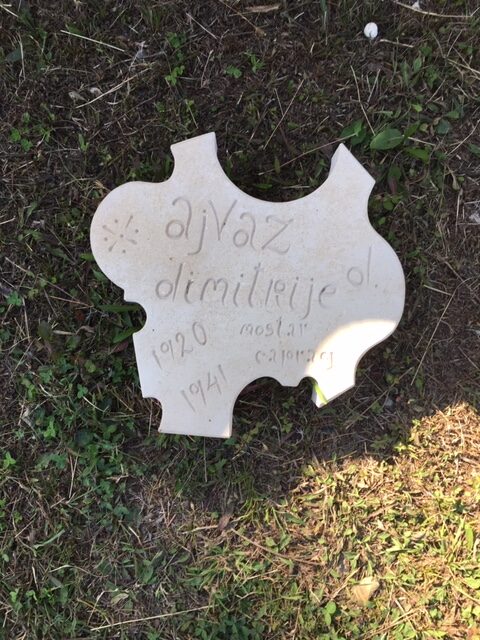
brochure "Partizanski spomenik u Mostaru" (1980)
book “Spomenica Mostara 1941-1945.”
another document or proof of the memorial stone (e.g., a photograph).
Dimitrije Đ. AJVAZ
DIMITRIJE DIMŠO AJVAZ, son of ĐORĐO, born on October 24, 1920, in Mostar. Locksmith, member of SKOJ since 1938, and candidate for membership in the Communist Party of Yugoslavia (KPJ) since 1940. Arrested by the Ustaše in June 1941 and taken to the concentration camp Dvor na Uni, from where he was transferred to the Gospić concentration camp* on November 5, 1941, where he was killed.
Dimitrije’s brother Božidar, as well as their father Đorđo, were killed during the ustaše terror in Mostar in 1941.
On Dimitrije’s memorial plaque, Caprag near Sisak is listed as the place of death. It was also a camp where numerous Serbs from Mostar were deported in the early summer of 1941. In Mostar, proclamations were issued at that time stating that Serbs had to leave Mostar and move to Serbia in alphabetical order. Since his family name started with the letter A, Dimitrije could have been exiled in the first transport to the Caprag camp. In Caprag and Sisak, where a “relocation camp” was established, there was a camp for adults known as the “transit camp for refugees,” along with a camp for children called the “refugee children’s shelter.” The camp existed from July to September 1941.
Svetislav Mandić, a painter and poet from Mostar and Belgrade (Mostar, March 8, 1921 – Belgrade, October 4, 2003), dedicated a poem titled “Onaj sudnji dan” (That Doomsday) to his friends from school days who were killed or fallen. The poem includes verses that refer to the brothers Ajvaz:
“(…)
And how will I stand before the faces of my loved ones, those whom I have outlived by so many decades, who were once my peers, those who left with shattered foreheads that incomprehensible summer when they were twenty years old.
Whom will I meet there, with whom will I speak eloquently, silently converse? …
How will I stand before the silent student Milenko Ilić,
and the even quieter Živko Škoro,
how to stand before the brothers Ajvaz and Vasko Sorajić,
comrades from the alley, since childhood (…)”
*According to the information from the book “Memorial Book of Mostar 1941-1945.”
https://jadovno.com/logori-caprag-i-sisak/ ; Vikipedija; grupa autora: Spomenica Mostara 1941-1945. Fotografije: S. Demirović; https://radiosarajevo.ba/vijesti/bosna-i-hercegovina/kome-vise-smeta-partizansko-groblje/407307# ; https://seaddjulic.blogspot.com/2020/11/san-o-ndh.html?m=1&fbclid=IwAR157JN22QaMDY6nkjS9ASZ4EfYwexdDndZHVt-GvUvz8kePeGzHBXRE56w
Do you have more information about this fighter? Share your stories and photographs. Let's keep the memory alive!





